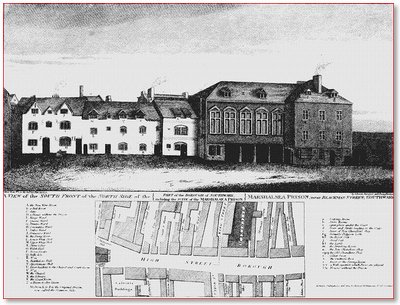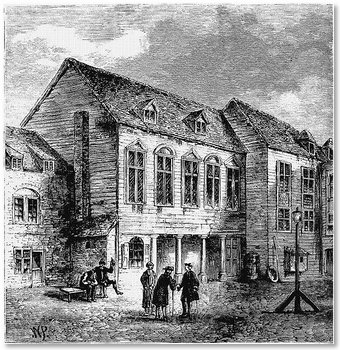Marshalsea Prison
Dickenslit.com - Places in Dickens - The Marshalsea

The Marshalsea Prison in 1773
|
|
The Marshalsea Prison was a debtors' prison which is mentioned frequently in the works of Charles Dickens.
The Marshalsea prison was located on the south bank of the River Thames in the London borough of Southwark, near London Bridge. For over 500 years (at least from 1329 until its closure in 1842) the prison housed those convicted of subversion, sailors who had mutinied, those accused of piracy and, above all, debtors who failed to pay their debts.
In Victorian England, people could be jailed indefinitely for nonpayment of debt. They would be held in a debtor's prison until the debt was paid. Although their family members were not forced to go to jail, it was commonplace for the wives and children of failed business men and other debtors to accompany them to the jail. Very often they had nowhere else to go, since the main bread winner of the family was imprisoned. Very often, these "free" family members would takes jobs outside of the jail during the day, returning only at night. The income that they earned helped pay off the debt of their jailed loved one, and keep him alive, for otherwise they would have had no way to buy food.
The prison was run by private individuals, like all English prisons of the 19th century and operated on a free market basis: the prisoners who could pay the rate had a bar, a restaurant, shop, and the privilege to be able to leave the prison during the day. All the others were herded into small rooms with dozens of other prisoners, imprisoned, often for several years even for small amounts of debt, which increased for non-payment of the prison's service fees.

Marshalsea Prison
In 1729 a British Parliamentary Committee found that 300 prisoners had died of starvation in a period of three months, and that every day between eight and ten prisoners died because of hot weather.
The prison became known as the 19th century through the works of English writer Charles Dickens, whose father was imprisoned in this prison for a debt of 40 pounds and 10 shillings when the novelist was twelve years old. As a result of his father's imprisonment, Dickens was forced to leave school and work in the factory to support herself. The experience deeply affected Dickens, and the imprisonment of debtors in the Marshalsea prison is a frequent theme in his novels (for example, Little Dorrit and the Pickwick Papers).
Most of the prison was demolished in 1849, although some of its buildings remained in use until the 1970s, housing a hardware store and a dairy and later the printshop of the Marshalsea Press. Today, what remains is a long brick wall and two gates, which lead to a small park and the local historical library. There is a small plaque set in the surviving wall which commemorates the prison and the work of Charles Dickens.
The name "Marshalsea" comes from the old English word "marshalcy" which refers to "the office, rank, position of a Marshal. This was the name of the medieval (circa 1200 A.D.) Marshalsea Court of Justice which was a court of special jurisdication, having jurisdiction over certain members of the royal family. The prison was originally built to hold prisoners convicted by the Marshalsea Court, but by the time of Charles Dickens its primary function was as a debtor's prison.

